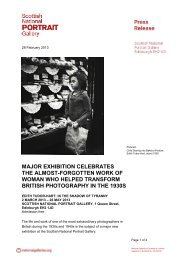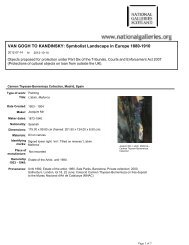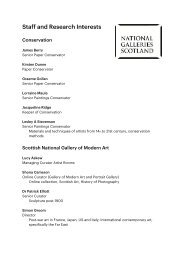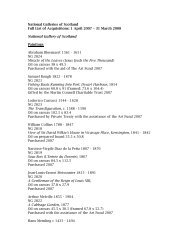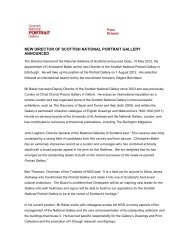Annual Review 2011-12 - National Galleries of Scotland
Annual Review 2011-12 - National Galleries of Scotland
Annual Review 2011-12 - National Galleries of Scotland
You also want an ePaper? Increase the reach of your titles
YUMPU automatically turns print PDFs into web optimized ePapers that Google loves.
Horse’s Skull, Sphere and Moon,<br />
1941<br />
by Peter Rose Pulham (1910–1956)<br />
Oil on canvas, 51 x 76cm<br />
Purchased with the assistance<br />
<strong>of</strong> the Art Fund. © The estate <strong>of</strong> the<br />
artist<br />
Peter Rose Pulham worked mainly<br />
as a photographer: moving between<br />
London and Paris in the 1930s, he<br />
made a celebrated series <strong>of</strong> photographs<br />
<strong>of</strong> Picasso. He was a close<br />
friend <strong>of</strong> Francis Bacon and knew<br />
many <strong>of</strong> the French Surrealists.<br />
He took up painting in the late<br />
1930s. Horse’s Skull, Sphere and<br />
Moon dates from 1941. The writer<br />
Theodora FitzGibbon recalled that<br />
Pulham bought the horse’s head<br />
from a butcher: ‘We soaked, washed,<br />
scrubbed, even cleaned the teeth,<br />
which we found lifted in and out <strong>of</strong><br />
the noble skull. It looked superb, like<br />
an unglazed T’ang head.’ Pulham’s<br />
work is rare, owing to a German<br />
bomb destroying his studio. This<br />
work, which joins the NGS’s great<br />
Surrealist collection, must count as<br />
one <strong>of</strong> his masterpieces.<br />
Untitled, from the series ‘The Brave<br />
Ones’, 2010<br />
by Zwelethu Mthethwa (b.1960)<br />
Digital C-type print, 150 x 194.3cm<br />
Purchased with the assistance <strong>of</strong> the Art<br />
Fund. © Courtesy <strong>of</strong> the artist and Jack<br />
Shainman Gallery, NY<br />
From Mthethwa’s recent series, The Brave<br />
Ones, this image depicts two boys from the<br />
Shembe Nazareth Baptist religious community<br />
in South Africa, a denomination that<br />
blends Christian and Zulu traditions.<br />
Its young male adherents adopt special<br />
costumes based on the kilt for religious<br />
ceremonies, <strong>of</strong>ten performed on the edges<br />
<strong>of</strong> forests (the boys refer to themselves as<br />
the ‘Iscotch’). The influence is drawn from<br />
Scottish regiments that were present in<br />
Natal in the late nineteenth century.<br />
Self-portrait, 1986–7<br />
by Alison Watt (b.1965)<br />
Oil on canvas, 30.8 x 30.8cm<br />
Presented by the Art Fund in December <strong>2011</strong> to celebrate<br />
the reopening <strong>of</strong> the Scottish <strong>National</strong> Portrait<br />
Gallery. © Alison Watt<br />
This self-portrait was painted while Alison Watt,<br />
one <strong>of</strong> <strong>Scotland</strong>’s most distinguished contemporary<br />
artists, was still a student at Glasgow School<br />
<strong>of</strong> Art. Watt is best known for her enigmatic<br />
paintings <strong>of</strong> drapery, but, even in these seemingly<br />
abstracted works, there is a powerful sense <strong>of</strong> the<br />
human body implied by the folds and creases. Watt<br />
painted images <strong>of</strong> herself obsessively in her early<br />
career, and, although she has rarely engaged in<br />
formal portraiture, self-representation remains<br />
an important element <strong>of</strong> her work. This acquisition<br />
underlines the commitment <strong>of</strong> the Scottish<br />
<strong>National</strong> Portrait Gallery to exploring contemporary<br />
portraiture and showcasing Scottish talent.<br />
‘Self-portrait: Scratched out, it’s all in<br />
the wrist’, c.2006<br />
by Steven Campbell (1953–2007)<br />
Oil on canvas, 183.5 x 133.5cm<br />
Purchased with the assistance <strong>of</strong> the Patrons<br />
<strong>of</strong> the <strong>National</strong> <strong>Galleries</strong> <strong>of</strong> <strong>Scotland</strong> <strong>2011</strong>.<br />
© The estate <strong>of</strong> Steven Campbell<br />
Steven Campbell was one <strong>of</strong> the most<br />
prominent painters to emerge in the revival<br />
<strong>of</strong> Glasgow as an art centre in the 1970s<br />
and 1980s. This theatrical and complex<br />
self-portrait is one <strong>of</strong> the last paintings<br />
Campbell completed before his untimely<br />
death in 2007. It is filled with a rich narrative,<br />
incorporating figures and symbols,<br />
mixed together in a dream-like composition.<br />
The artist presents himself as a Christ<br />
figure, displaying his palms which show<br />
the stigmata. To the left, a cross is marked<br />
out with police tape, which, as testament<br />
to Campbell’s dark humour, reads ‘Police.<br />
Death in Progress’. He takes this further<br />
with a skull visible at the base <strong>of</strong> the cross,<br />
a reference to Golgotha, the place where<br />
Christ was crucified. Crammed with death<br />
and religious symbolism, it is hard not to<br />
consider this work as a portrait <strong>of</strong> a man<br />
in some way aware that death was on<br />
his doorstep.<br />
31



